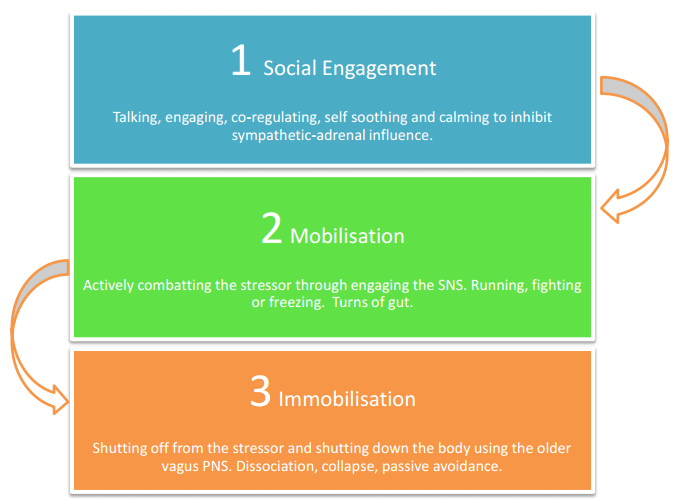Understanding our response to traumatic events.
By Sarah McMahon
When faced with danger, threat, fear, stress or trauma, why is it that we respond differently to the next person? Why do we engage in different survival-defensive behaviours? Why is it that some of us ‘fight’, some of us ‘flight’, whilst others go into shut down mode? Many of us are familiar with the “fight or flight” response. Stephen Porges’ (1995, 1997, 1998, 2001) ‘Polyvagal theory’ (PVT) takes this theory further and helps to explain and broaden our understanding of the nervous system and how it responds to trauma. According to Porges, each branch of the vagus nerve (ventral and dorsal) is linked with a different behavioural and physiological response in the face of trauma.
We are biologically driven to respond to distress using a predictable framework: (i) Social engagement. This is our most natural state of rest and safety. It enables us to “tend and befriend”- have connection with others, to relax, play, love and so forth. When we are in danger it is natural that we attempt to use our social nervous system and turn to this environment for reassurance, connection and safety. However if we are unsuccessful (our parent, care giver, partner or friend is unresponsive or uninterested) our newer vagus shuts off and (ii) Mobilisation takes over. If our attempts to defend ourselves through mobilised fight, flight or active freeze responses are also unsuccessful (we are not quick enough, loud enough, strong enough to protect ourselves or engage protection) we (iii) drop down the hierarchy again and our dorsal vagus initiates immobilised defence responses, such as dissociation, shutting us down and diverting energy to preservation of life on the inside, whilst potentially even feigning death on the outside.

What this means is:
- PVT explains how we look to those around us to help contextualise danger
- PVT also then helps us understand how in some instances our distress response may not be activated. Consider sexual abuse where grooming has taken place. The normalisation of the environment and behaviour by a perpetrator may prevent activation of the nervous system
- PVT helps us to understand a dissociative response- why in some very dangerous situations our body may actually prevent us from responding at all. It is important we remember this is a survival response.
- PVT also helps us to understand the impact of sustained trauma. Over time, if the social engagement system is not used successfully one will decrease capacity to use this and develop a ‘hard-wired‘ autonomic nervous system response to trauma and its triggers. As more and more of the world is perceived as unsafe, these people may come to rely on their defensive states to negotiate their environments, making social engagement very difficult.
- Finally, this theory highlights the value and importance of human relationship. When we are in a “fight or flight” response, or when we are immobilised it highlights that we are experiencing defensive reactions of the nervous system. This may be due to real threats, however if we have experienced a history of trauma this activation will also occur from perceived threats. The ultimate aim is to firstly be safe and secondly return our central nervous system to the state where we can rely on Social
Sarah McMahon has worked in the field of eating disorders for approximately 15 years, supporting hundreds of people to achieve recovery. www.bodymatters.com.au


